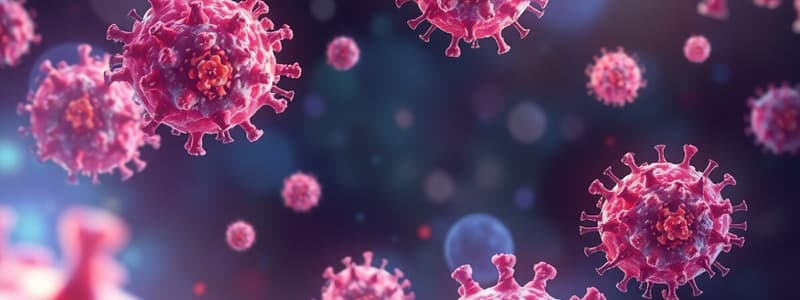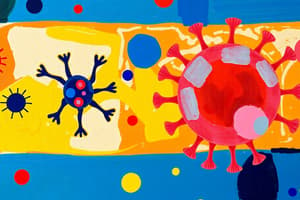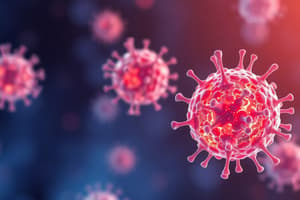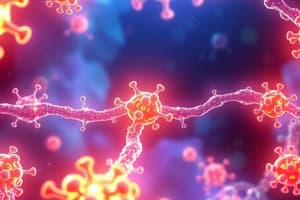Podcast
Questions and Answers
What type of immune response is associated with a delayed onset and short duration?
What type of immune response is associated with a delayed onset and short duration?
- Neither humoral nor cell-mediated immunity
- Humoral immunity (correct)
- Both humoral and cell-mediated immunity
- Cell-mediated immunity
Which immunoglobulin isotype is primarily associated with the early stages of an immune response?
Which immunoglobulin isotype is primarily associated with the early stages of an immune response?
- IgA
- IgM (correct)
- IgE
- IgG
Which of the following cytokines are primarily associated with the cell-mediated immune response?
Which of the following cytokines are primarily associated with the cell-mediated immune response?
- IL-4, IL-5, IL-10, IL-13
- IL-2, IL-12, IFNγ (correct)
- TGF-β
- All of the above
What type of cells are responsible for producing immunoglobulins?
What type of cells are responsible for producing immunoglobulins?
Which immunoglobulin isotype is primarily involved in allergic reactions?
Which immunoglobulin isotype is primarily involved in allergic reactions?
What is the role of CD40L on T helper 2 cells in T-dependent B cell activation?
What is the role of CD40L on T helper 2 cells in T-dependent B cell activation?
Which of the following statements accurately describes the primary immune response?
Which of the following statements accurately describes the primary immune response?
T-independent activation of B cells is characterized by:
T-independent activation of B cells is characterized by:
How does the secondary immune response differ from the primary immune response?
How does the secondary immune response differ from the primary immune response?
Which of the following cytokines is NOT produced by T helper 2 cells during T-dependent B cell activation?
Which of the following cytokines is NOT produced by T helper 2 cells during T-dependent B cell activation?
Which immunoglobulin isotype is primarily involved in the defense against parasites?
Which immunoglobulin isotype is primarily involved in the defense against parasites?
Which pathway of complement activation is initiated by antigen-antibody complexes?
Which pathway of complement activation is initiated by antigen-antibody complexes?
Which immunoglobulin isotype is the most abundant in serum?
Which immunoglobulin isotype is the most abundant in serum?
Which immunoglobulin isotype can cross the placenta?
Which immunoglobulin isotype can cross the placenta?
Which of the following describes the function of the membrane attack complex (MAC) in the complement system?
Which of the following describes the function of the membrane attack complex (MAC) in the complement system?
Flashcards
B Cell Activation
B Cell Activation
The process where B cells are stimulated to respond to antigens, leading to antibody production.
T-independent activation
T-independent activation
B cell activation that occurs without T helper cell assistance, often by polysaccharides.
T-dependent activation
T-dependent activation
B cell activation requiring T helper cells to present the antigen through MHC II.
Primary Immune Response
Primary Immune Response
Signup and view all the flashcards
Secondary Immune Response
Secondary Immune Response
Signup and view all the flashcards
Immunoglobulins (Ig)
Immunoglobulins (Ig)
Signup and view all the flashcards
Types of Immunoglobulins
Types of Immunoglobulins
Signup and view all the flashcards
Heavy Chains in Immunoglobulins
Heavy Chains in Immunoglobulins
Signup and view all the flashcards
Function of Immunoglobulins
Function of Immunoglobulins
Signup and view all the flashcards
T Regulatory Cells
T Regulatory Cells
Signup and view all the flashcards
IgM
IgM
Signup and view all the flashcards
IgA
IgA
Signup and view all the flashcards
Complement System
Complement System
Signup and view all the flashcards
Classical Pathway
Classical Pathway
Signup and view all the flashcards
Mannan-binding Lectin Pathway
Mannan-binding Lectin Pathway
Signup and view all the flashcards
Study Notes
Innate and Adaptive Immune Response (III)
- B cell activation is crucial for humoral immunity
- T-independent activation occurs without T helper cells
- Polysaccharides bind to BCRs (surface IgD & IgM) on B cells
- Complement receptors (CD21, CD35) are involved
- Clinical example: Capsular polysaccharide of Haemophilus influenzae B
- T-dependent activation requires T helper cells
- B cells bind to antigens using B cell receptors (surface IgD & IgM)
- The B cell presents the antigen with MHC II complex to activate CD4 T cells
- CD80/86 on B cells bind to CD28 on T helper 2 cells
- CD40 on B cells bind to CD40L on T helper 2 cells
- T helper 2 cells release IL-4, IL-5, IL-6, and IL-13
- This leads to B cell proliferation and differentiation into B memory cells and plasma cells
- Plasma cells produce and secrete IgM (primary immune response)
- Memory B cells rapidly respond to re-exposure
- They differentiate into plasma cells producing more IgM, IgG, and IgA (secondary immune response)
- Primary vs. Secondary Immune Response
Feature Primary Secondary Exposure First time Second, third, or more Antigen dose High Low Antibody type Primarily IgM IgM, IgG, IgA Onset Delayed Rapid Duration Short Long
Immunoglobulins (Antibodies) (Ig)
- Immunoglobulins (Ig) are glycoproteins
- Mediate humoral immunity
- Produced by plasma cells
- Two forms: membrane-bound (IgM & BCRs) and secreted
- Five classes: three major (IgG, IgM, IgA) and two minor (IgD and IgE)
- Basic structure
- Four polypeptide chains (two identical heavy chains, two identical light chains) held together by disulfide bonds in a Y-shape
- Antibody carries one type of light chain (kappa or lambda)
- Light chains have one variable (VL) and one constant (CL) domain
- Heavy chains have one variable (VH) and three or four constant (CH) domains
- Functions of different Ig isotypes
- Block binding of microbes or toxins to cells
- Opsonization and phagocytosis
- Antibody-dependent cellular cytotoxicity (ADCC)
- Activation of the classical complement pathway by IgG and IgM
Complement System
- Circulating and membrane-associated proteins that function in both innate and adaptive immune responses
- Synthesized in the liver and present in inactive forms in serum
- Components include C1 to C9 and factors B, D, and P
- Complement Pathways
- Classical pathway (adaptive): activated by antigen-antibody complexes (IgM & IgG)
- Mannan-binding lectin pathway (innate): MBL binds to mannose residues on microbes, activating MBL-activated serine proteases (MASP1 & MASP2)
- Alternative pathway (innate): bacterial endotoxin (LPS) directly produces spontaneous breakdown of C3 (C3a & C3b)
- Functions of the Complement system
- Complement-mediated lysis: the membrane attack complex (MAC) induces osmotic lysis of target cells
- Opsonization and phagocytosis: (C3b or C4b) enhancing phagocytosis of microbes by binding to them.
- Mediators of inflammation and chemo-attractants to phagocytes: (C3a, C4a, C5a)
Study Questions
- Classical Pathway initiation
- Antigen-antibody complexes (IgM and IgG)
- Alternative Pathway initiation
- Lipopolysaccharides (LPS) of gram-negative bacteria
Cytokines
- Cytokines have various clinical uses (e.g., treatment of thrombocytopenia, bone marrow recovery, anemia with renal failure)
Studying That Suits You
Use AI to generate personalized quizzes and flashcards to suit your learning preferences.




